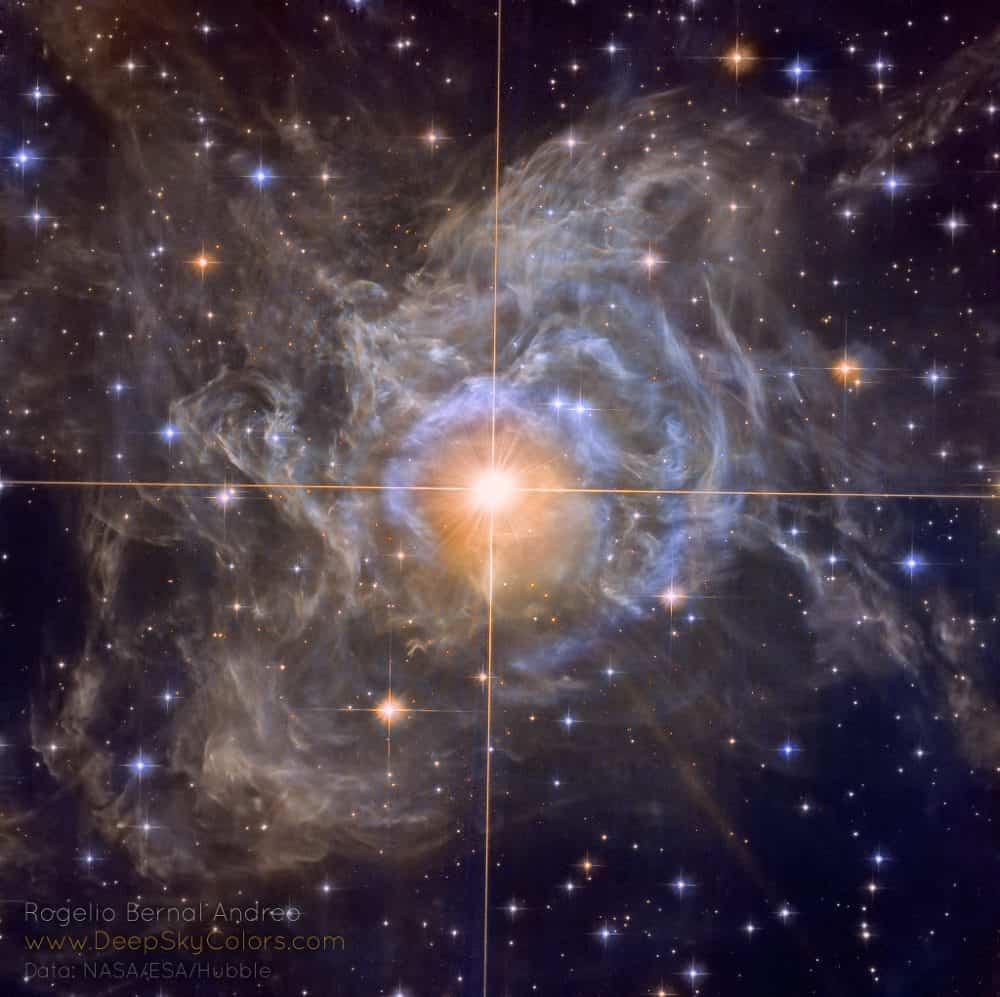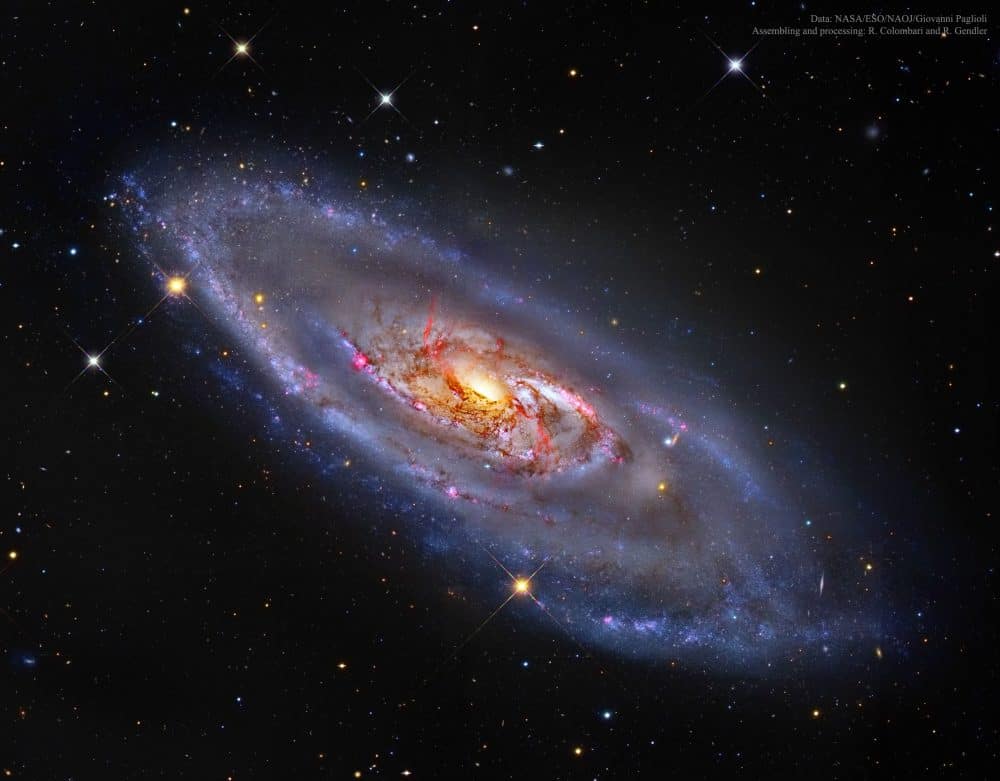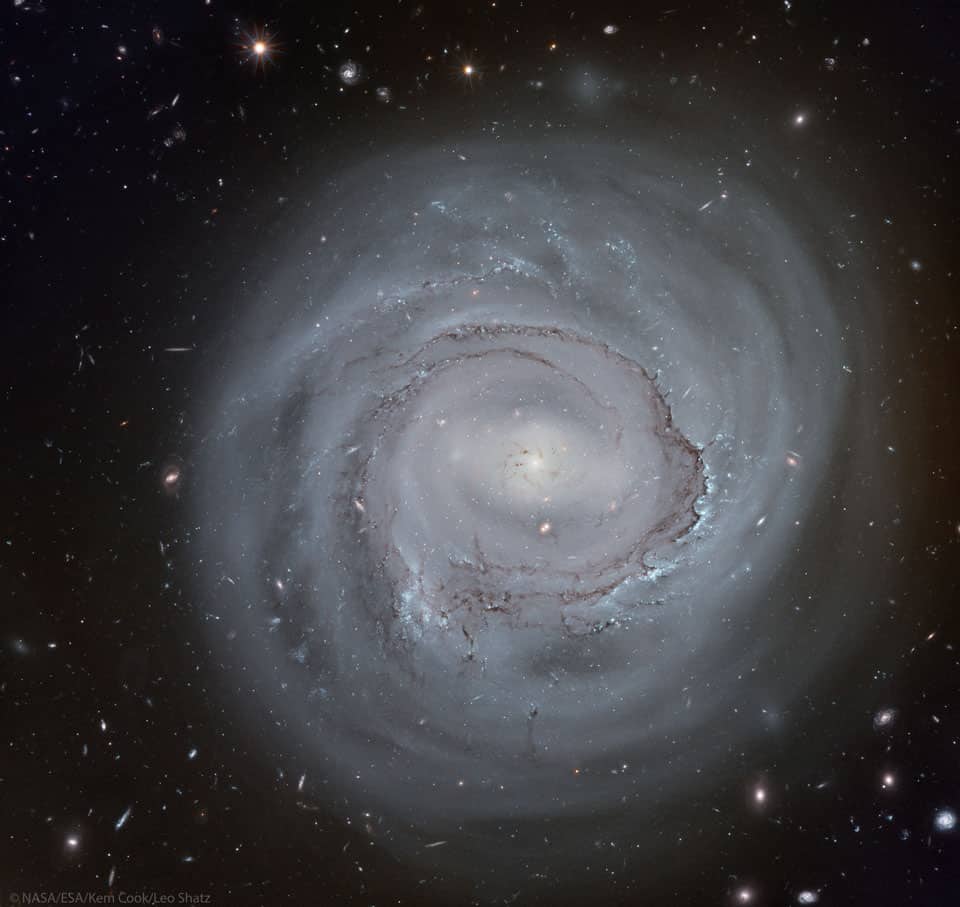Blog
Pulsating RS Puppis, the brightest star in the image center, is some ten times more massive than our Sun and on average 15,000 times more luminous. In fact, RS Pup is a Cepheid variable star, a class of stars whose brightness is used to estimate distances to nearby galaxies as one of the first steps in establishing the cosmic distance scale. As RS Pup pulsates over a period of about 40 days, its regular changes in brightness are also seen along its surrounding nebula delayed in time, effectively a light echo. Using measurements of the time delay and angular size of the nebula, the known speed of light allows astronomers to geometrically determine the distance to RS Pup to be 6,500 light-years, with a remarkably small error of plus or minus 90 light-years. An impressive achievement for stellar astronomy, the echo-measured distance also more accurately establishes the true brightness of RS Pup, and by extension other Cepheid stars, improving the knowledge of distances to galaxies beyond the Milky Way.
more...William Scott Bruford (born 17 May 1949) is an English retired drummer, percussionist, songwriter, producer, and record label owner who first gained prominence as the original drummer of the rock band Yes, from 1968 to 1972 and again from 1990 to 1992. After his departure from Yes, Bruford spent the rest of the 1970s playing in King Crimson, touring with Genesis and U.K., and eventually forming his own group, Bruford.
In the 1980s, Bruford returned to King Crimson for three years, collaborated with several artists including The Roches, Patrick Moraz, and David Torn, and formed his jazz band Earthworks in 1986. He then played in Anderson Bruford Wakeman Howe, which eventually led to his second stint in Yes. Bruford played in King Crimson for his third and final tenure between 1994 and 1997, after which he continued with Earthworks and further collaborations.
On 1 January 2009, Bruford retired from public performance, barring one private gig in 2011. He released his autobiography, and continues to speak and write about music. He operates his record labels, Summerfold and Winterfold Records. In 2016, after four-and-a-half years of study, Bruford earned a PhD in Music at the University of Surrey. He was inducted into the Rock and Roll Hall of Fame as a member of Yes in 2017
https://www.youtube.com/watch?v=93y9wfB3EM8
more...Henry Saint Clair Fredericks (born May 17, 1942), who uses the stage name Taj Mahal, is an American blues musician, a singer-songwriter and film composer who plays the guitar, piano, banjo, harmonica, and many other instruments. He often incorporates elements of world music into his works and has done much to reshape the definition and scope of blues music over the course of his more than 50-year career by fusing it with nontraditional forms, including sounds from the Caribbean, Africa, and the South Pacific.
Born Henry Saint Clair Fredericks, Jr. on May 17, 1942, in Harlem, New York, Mahal grew up in Springfield, Massachusetts. He was raised in a musical environment; his mother was a member of a local gospel choir and his father was an Afro-Caribbean jazz arranger and piano player. His family owned a shortwave radio which received music broadcasts from around the world, exposing him at an early age to world music.
In 1964 he moved to Santa Monica, California, and formed Rising Sons with fellow blues rock musician Ry Cooder and Jessie Lee Kincaid, landing a record deal with Columbia Records soon after. The group was one of the first interracial bands of the period, which likely made them commercially unviable. An album was never released (though a single was) and the band soon broke up, though Legacy Records did release The Rising Sons Featuring Taj Mahal and Ry Cooder in 1992 with material from that period. During this time Mahal was working with others, musicians like Howlin’ Wolf, Buddy Guy, Lightnin’ Hopkins, and Muddy Waters. Mahal stayed with Columbia after the Rising Sons to begin his solo career, releasing the self-titled Taj Mahal in 1968, The Natch’l Blues in 1969, and Giant Step/De Old Folks at Home with Kiowa session musician Jesse Ed Davis from Oklahoma, who played guitar and piano (also in 1969).During this time he and Cooder worked with the Rolling Stones, with whom he has performed at various times throughout his career. In 1968, he performed in the film The Rolling Stones Rock and Roll Circus. He recorded a total of twelve albums for Columbia from the late 1960s into the 1970s. His work of the 1970s was especially important, in that his releases began incorporating West Indian and Caribbean music, jazz and reggae into the mix. In 1972, he acted in and wrote the film score for the movie Sounder, which starred Cicely Tyson. He reprised his role and returned as composer in the sequel, Part 2, Sounder.
In 1976 Mahal left Columbia and signed with Warner Bros. Records, recording three albums for them. One of these was another film score for 1977’s Brothers; the album shares the same name. After his time with Warner Bros., he struggled to find another record contract, this being the era of heavy metal and disco music.
John Lenwood “Jackie” McLean (May 17, 1931 – March 31, 2006) was an American jazz alto saxophonist, composer, bandleader, and educator, and is one of the few musicians to be elected to the DownBeat Hall of Fame in the year of their death.
McLean was born in New York City. His father, John Sr., played guitar in Tiny Bradshaw‘s orchestra. After his father’s death in 1939, Jackie’s musical education was continued by his godfather, his record-store-owning stepfather, and several noted teachers. He also received informal tutoring from neighbors Thelonious Monk, Bud Powell, and Charlie Parker. During high school he played in a band with Kenny Drew, Sonny Rollins, and Andy Kirk Jr. (the tenor saxophonist son of Andy Kirk).
Along with Rollins, he played on Miles Davis‘ Dig album, when he was 20 years old. As a young man McLean also recorded with Gene Ammons, Charles Mingus (for Pithecanthropus Erectus), George Wallington, and as a member of Art Blakey‘s Jazz Messengers. McLean joined Blakey after reportedly being punched by Mingus. Fearing for his life, McLean pulled out a knife and contemplated using it against Mingus in self-defense. He later stated that he was grateful that he had not stabbed the bassist.
His early recordings as leader were in the hard bop school. He later became an exponent of modal jazz without abandoning his foundation in hard bop. Throughout his career he was known for a distinctive tone, akin to the tenor saxophone and often described with such adjectives as “bitter-sweet”, “piercing”, or “searing”, a slightly sharp pitch, and a strong foundation in the blues.
McLean was a heroin addict throughout his early career, and the resulting loss of his New York City cabaret card forced him to undertake a large number of recording dates to earn income in the absence of nightclub performance opportunities. Consequently, he produced an extensive body of recorded work in the 1950s and 1960s. He was under contract with Blue Note Recordsfrom 1959 to 1967, having previously recorded for Prestige. Blue Note offered better pay and more artistic control than other labels, and his work for this organization is highly regarded and includes leadership and sideman dates with a wide range of musicians, including Donald Byrd, Sonny Clark, Lee Morgan, Ornette Coleman, Dexter Gordon, Freddie Redd, Billy Higgins, Freddie Hubbard, Grachan Moncur III, Bobby Hutcherson, Mal Waldron, Tina Brooks and many others.
more...a marvelous spiral that shines at magnitude 8.4 and is one of the sky’s brightest galaxies. It spans 20′ by 8.4′. Through a 10-inch or larger telescope, you’ll begin to see the mottled texture and spiral structure. The strikingly linear northern arm appears more pronounced, while the southern arm looks more diffuse.
Messier 106 (also known as NGC 4258) is an intermediate spiral galaxy in the constellation Canes Venatici. It was discovered by Pierre Méchain in 1781. M106 is at a distance of about 22 to 25 million light-years away from Earth. M106 contains an active nucleus classified as a Type 2 Seyfert, and the presence of a central supermassive black hole has been demonstrated from radio-wavelength observations of the rotation of a disk of molecular gas orbiting within the inner light-year around the black hole. NGC 4217 is a possible companion galaxy of Messier 106. A Type II supernova was observed in M106 in May 2014.
more...
William Emanuel Cobham Jr. (born May 16, 1944) is a Panamanian-American jazz drummer who came to prominence in the late 1960s and early 1970s with trumpeter Miles Davis and then with the Mahavishnu Orchestra. According to AllMusic‘s reviewer, Cobham is “generally acclaimed as fusion’s greatest drummer”.
He was inducted into the Modern Drummer Hall of Fame in 1987 and the Classic Drummer Hall of Fame in 2013.
Born in Colón, Panama, Cobham moved with his family to Brooklyn, New York, when he was three. His father worked as a hospital statistician during the week and played piano on weekends. Cobham started on drums at age four and joined his father four years later. When he was fourteen, he got his first drum kit as a gift after being accepted to The High School of Music & Art in New York City. He was drafted in 1965, and for the next three years he played with a U.S. Army band.
After his discharge, he became a member of Horace Silver‘s quintet. He played an early model electric drum kit given to him by Tama Drums. He was a house drummer for Atlantic Recordsand a session musician for CTI and Kudu, appearing on the albums White Rabbit by George Benson, Sunflower by Milt Jackson, and Soul Box by Grover Washington Jr.
Cobham started the jazz rock group Dreams with Michael Brecker, Randy Brecker, and John Abercrombie.[1] He moved further into jazz fusion when he toured with Miles Davis and recorded Davis’s albums Bitches Brew and A Tribute to Jack Johnson. In 1971, he and guitarist John McLaughlin left Davis to start the Mahavishnu Orchestra, another group that fused rock, funk, and jazz.[4] Cobham toured extensively from 1971 to 1973 with the Mahavishnu Orchestra, which released two studio albums, The Inner Mounting Flame (1971) and Birds of Fire (1973), and one live album, Between Nothingness & Eternity (1973). The studio versions of songs on the live album were released on The Lost Trident Sessions (1999).
https://www.youtube.com/watch?v=k8hIqIGSY54
more...Robert Fripp (born 16 May 1946) is an English guitarist, composer and record producer. As a guitarist for the progressive rock band King Crimson, Fripp has been the only member to have played in all of King Crimson’s line-ups from their inception in the late 1960s to the present. He has also worked extensively as a studio musician, notably with David Bowie on the albums “Heroes” and Scary Monsters (and Super Creeps), Brian Eno, David Sylvian and contributed sounds to the Windows Vista operating system.His complete discography lists more than seven hundred releases over five decades.
He is ranked 62nd on Rolling Stone magazine’s 2011 list of the 100 Greatest Guitarists of All Time after having been ranked by David Fricke 42nd on its 2003 list. Tied with Andrés Segovia, he also is ranked 47th on Gibson’s Top 50 guitarists of all time.
His compositions often feature unusual time signatures, which have been influenced by classical and folk traditions. His innovations include Frippertronics, soundscapes, and new standard tuning.
more...Betty Carter (born Lillie Mae Jones; May 16, 1930 – September 26, 1998) was an American jazz singer known for her improvisational technique, scatting and other complex musical abilities that demonstrated her vocal talent and imaginative interpretation of lyrics and melodies. Vocalist Carmen McRae once remarked: “There’s really only one jazz singer—only one: Betty Carter.”
Carter was born in Flint, Michigan, and grew up in Detroit, where her father, James Jones, was the musical director of a Detroit church and her mother, Bessie, was a housewife. As a child, Carter was raised to be extremely independent and to not expect nurturing from her family.
Even at a young age, Carter was able to bring a new vocal style to jazz. The breathiness of her voice was a characteristic seldom heard before her appearance on the music scene. She also was well known for her passion for scat singing and her strong belief that the throwaway attitude that most jazz musicians approached it with was inappropriate and wasteful due to its spontaneity and basic inventiveness, seldom seen elsewhere.
Detroit, where Carter grew up, was a hotbed of jazz growth. After signing with a talent agent after her win at amateur night, Carter had opportunities to perform with famous jazz artists such as Dizzy Gillespie, who visited Detroit for an extensive amount of time. Gillespie is often considered responsible for her strong passion for scatting. In earlier recordings, it is apparent that her scatting had similarities to the qualities of Gillespie’s.
At the time of Gillespie’s visit, Charlie Parker was receiving treatment in a psychiatric hospital, delaying her encounter with him. However, Carter eventually performed with Parker, as well as with his band consisting of Tommy Potter, Max Roach, and Miles Davis. After receiving praise from both Gillespie and Parker for her vocal prowess, Carter felt a strong burst in confidence and knew that she could make it in the business with perseverance.
Carter was right. In 1948, Carter was asked by Lionel Hampton to join his band. She finally had her big break. Working with Hampton’s group gave her the chance to be bandmates with artists such as Charles Mingus and Wes Montgomery, as well as with Ernest Harold “Benny” Bailey, who had recently vacated Gillespie’s band and Albert Thornton “Al” Grey who would later go on to join Gillespie’s band. Hampton obviously had an ear for talent and a love for bebop.
https://www.youtube.com/watch?v=Wi2II6fC6PQ
more...Let’s go Viral! It’s on YouTube now at 35:40 or the last 8 minutes approx.
https://youtu.be/dbD74u63v_0?fbclid=IwAR3TmLdWqsWUp4sQ9M3E5lqYw4Gt9PeyyMBi2YW-zyseepjeQdE5BLH1uNc
more...Although presently estimated to be about 300 million light years distant, a more precise determination could be coupled with its known recession speed to help humanity better calibrate the expansion rate of the entire visible universe. Toward this goal, several images were taken by the Hubble Space Telescope in order to help identify key stellar distance markers known as Cepheid variable stars. Since NGC 4921 is a member of the Coma Cluster of Galaxies, refining its distance would also allow a better distance determination to one of the largest nearby clusters in the local universe. The magnificent spiral NGC 4921 has been informally dubbed anemic because of its low rate of star formation and low surface brightness. Visible in the featured image are, from the center, a bright nucleus, a bright central bar, a prominent ring of dark dust, blue clusters of recently formed stars, several smaller companion galaxies, unrelated galaxies in the far distant universe, and unrelated stars in our Milky Way Galaxy.
more...Brian Peter George St John le Baptiste de la Salle Eno, RDI (/ˈiːnoʊ/; born Brian Peter George Eno, 15 May 1948) is an English musician, record producer, and visual artist best known for his pioneering work in ambient music and contributions to rock, pop, electronic, and generative music. A self-described “non-musician”, Eno has helped introduce a variety of conceptual approaches and recording techniques to contemporary music, advocating a methodology of “theory over practice, serendipity over forethought, and texture over craft” according to AllMusic. He has been described as one of popular music‘s most influential and innovative figures.
Born in Suffolk, Eno studied painting and experimental music at the art school of Ipswich Civic College in the mid 1960s, and then at Winchester School of Art. He joined glam rock group Roxy Music as synthesiser player in 1971. After recording two albums with Roxy Music, he departed in 1973 to record a number of solo albums, coining the term “ambient music” to describe his work on releases such as Another Green World (1975), Discreet Music (1975), and Music for Airports (1978). He also collaborated with artists such as Robert Fripp, Cluster, Harold Budd, David Bowie on his “Berlin Trilogy“, and David Byrne, and produced albums by artists including John Cale, Jon Hassell, Laraaji, Talking Heads and Devo, and the no wave compilation No New York (1978).
Eno has continued to record solo albums and work with artists including U2, Laurie Anderson, Grace Jones, Slowdive, Coldplay, James Blake, and Damon Albarn. Dating back to his time as a student, he has also worked in media including sound installations and his mid-70s co-development of Oblique Strategies, a deck of cards featuring cryptic aphorisms intended to spur creative thinking. From the 1970s onwards, Eno’s installations have included the sails of the Sydney Opera House in 2009 and the Lovell Telescope at Jodrell Bank in 2016. An advocate of a range of humanitarian causes, Eno writes on a variety of subjects and is a founding member of the Long Now Foundation. In 2019, Eno was inducted into the Rock and Roll Hall of Fameas a member of Roxy Music.
https://www.youtube.com/watch?v=-dikWB6wm0A
more...Ellis Larkins (May 15, 1923 – September 30, 2002) was an American jazz pianist born in Baltimore, Maryland, perhaps best known for his two recordings with Ella Fitzgerald: the albums Ella Sings Gershwin (1950) and Songs in a Mellow Mood (1954).[1] He was also the leader in the first solo sides by singer Chris Connor on her album Chris (1954).
Larkins was the first African American to attend the Peabody Conservatory of Music, a well-known institute in Baltimore. He began his professional playing career in New York City after moving there to attend the Juilliard School. Following school Larkins performed jazz piano with Billy Moore and Edmond Hall. He recorded with Coleman Hawkins, Mildred Bailey, and Dicky Wells in the 1940s. In the 1950s he recorded with Ella Fitzgerald, Ruby Braff, and Beverly Kenney. His 1960s work included recordings or performances with Eartha Kitt, Joe Williams, Helen Humes, Georgia Gibbs and Harry Belafonte.
Though he was best known as an accompanist, Larkins recorded several solo albums in the 1950s. In the 1970s he performed regularly at several New York venues, including Gregory’s, a small bar on the Upper East Side.
more...More Posts
- MAROONS Minnetonka Community Center
- Cosmos M106
- Camille Saint-Saëns
- John Lennon
- Abdullah Ibrahim
- Yusef Lateef
- World Music Silkroad Ensemble with Rhiannon Giddens
- Daily Roots Monkey Man
- Marcus Garvey Intelligence
- Chief Sitting Bull Rights
- Cosmos M100
- Hamish Stuart
- Sonny Igoe
- Pepper Adams
- World Music Xabier Díaz
- Daily Roots Subatomic Sound System
- One Year Anniversary of Israel Attack & Gaza War
- Cosmos NGC 5248
- Yo-Yo Ma
- Mel Brown



